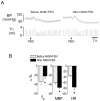Contribution of central μ-receptors to switching pulmonary C-fibers-mediated rapid shallow breathing into an apnea by fentanyl in anesthetized rats
- PMID: 22759907
- PMCID: PMC3411907
- DOI: 10.1016/j.brainres.2012.06.028
Contribution of central μ-receptors to switching pulmonary C-fibers-mediated rapid shallow breathing into an apnea by fentanyl in anesthetized rats
Abstract
Our previous study has shown that activating peripheral μ-receptors is necessary for switching the bronchopulmonary C-fibers (PCFs)-mediated rapid shallow breathing (RSB) into an apnea by systemic administration of fentanyl. The brainstem nuclei, such as the medial nucleus tractus solitarius (mNTS) and the pre-Botzinger complex (PBC), are required for completing the PCF-mediated respiratory reflexes. Moreover, these areas contain abundant μ-receptors and their activation prolongs expiratory duration (T(E)). Thus, we asked if central μ-receptors, especially those in the mNTS and PBC, are involved in fully expressing this RSB-apnea switch by fentanyl. In anesthetized rats, the cardiorespiratory responses to right atrial injection of phenylbiguanide (PBG, 3-6μg/kg) were repeated after: (1) fentanyl (iv), a μ-receptor agonist, alone (8μg/kg, iv); (2) fentanyl following microinjection of naloxone methiodide (NXM, an opioid receptor antagonist) into the cisterna magna (10μg/4μl); (3) the bilateral mNTS (10mM, 20nl); or (4) PBC (10mM, 20nl). Our results showed that PBG shortened T(E) by 37±6% (RSB, from 0.41±0.05 to 0.26±0.03s, P<0.01), but it markedly prolonged T(E) by 5.8-fold (an apnea, from 0.50±0.04s to 2.9±0.57s, P<0.01) after fentanyl (iv). Pretreatment with NXM injected into the cisterna magna or the PBC, but not the mNTS, prevented the fentanyl-induced switch. This study, along with our previous results mentioned above, suggests that although peripheral μ-receptors are essential for triggering the fentanyl-induced switch, central μ-receptors, especially those in the PBC, are required to fully exhibit such switch.
Summary statement: Our results suggest that the activation of central μ-receptors, especially those in the pre-Botzinger complex, is required for switching the pulmonary C-fiber-mediated rapid shallow breathing into an apnea by systemic administration of fentanyl.
Copyright © 2012 Elsevier B.V. All rights reserved.
Figures




References
-
- Ang KK, et al. Activation of spinal opioid receptors contributes to hypotension after hemorrhage in conscious rats. Am J Physiol. 1999;276:H1552–8. - PubMed
Publication types
MeSH terms
Substances
Grants and funding
LinkOut - more resources
Full Text Sources
Research Materials

